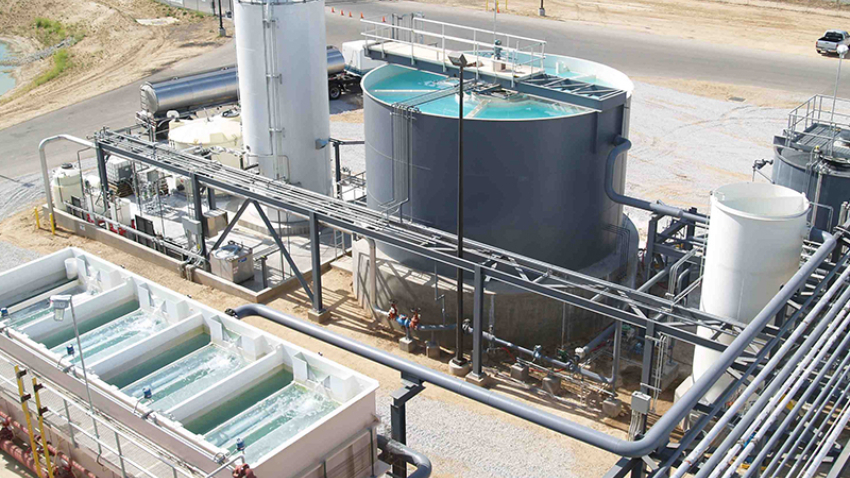
Zero Liquid Discharge Plant in Gujarat

Zero Liquid Discharge
is an advanced water management strategy that aims to eliminate the discharge of liquid waste into the environment by recovering and reusing as much water as possible from industrial processes. ZLD systems are particularly pertinent in industries where water scarcity, environmental regulations, and sustainability initiatives are of paramount concern. By converting wastewater into solid by-products and reclaiming water for reuse, ZLD promotes efficient resource utilization and environmental stewardship.
Key Features of Zero Liquid Discharge:
- Maximized Water Recovery: ZLD systems are designed to recover nearly all the water from wastewater streams, significantly reducing reliance on freshwater sources and enhancing overall water conservation efforts.
- Minimization of Liquid Waste: Through advanced treatment processes, ZLD reduces liquid waste to negligible levels, facilitating the transformation of wastewater into solid materials or reusable products.
- Regulatory Compliance and Environmental Sustainability: ZLD systems assist industries in adhering to stringent environmental regulations regarding wastewater discharge, thereby fostering compliance and enhancing corporate sustainability initiatives.
Core Processes in Zero Liquid Discharge Systems
Pre-Treatment
- Screening and Filtration: Initial processes involve mechanical screening and filtration to eliminate large solids and particulates from the wastewater, preparing it for subsequent treatment stages.
Primary Treatment
- Sedimentation: In sedimentation tanks, suspended solids are allowed to settle under gravity, reducing the organic and solid load in the effluent prior to biological treatment.
Secondary Treatment
- Biological Treatment: This phase employs microbial processes to further degrade organic contaminants. Common methods include:
- Activated Sludge Process: Aerobic microorganisms metabolize organic matter in aeration tanks.
- Sequencing Batch Reactors (SBR): A flexible biological treatment method that operates in batch mode, optimizing retention time and operational efficiency.
Advanced Treatment:
- Membrane Technologies: Advanced filtration methods such as ultrafiltration (UF) and reverse osmosis (RO) are utilized to separate clean water from dissolved solids and contaminants, producing high-quality effluent suitable for reuse.
- Evaporation Techniques: Thermal or membrane-based evaporation processes concentrate the remaining liquid waste, facilitating the removal of water while leaving behind solid residues.
Solid Residue Management
The concentrated waste stream undergoes further processing, which may involve:
- Crystallization: Converting dissolved salts and other materials into solid crystals, which can be disposed of or reused.
- Disposal Methods: Options such as landfill disposal or incineration, in compliance with regulatory standards, are employed for final solid waste management.
Water Reuse
The reclaimed water is repurposed for various applications, including industrial processes, irrigation, and potentially potable uses, depending on the treatment efficacy and regulatory guidelines.
Advantages of Zero Liquid Discharge
- Conservation of Water Resources: ZLD significantly curtails freshwater consumption, making it particularly advantageous in arid regions and industries with high water usage.
- Environmental Protection: By eliminating liquid waste discharge, ZLD reduces the risk of water pollution and safeguards aquatic ecosystems from harmful contaminants.
- Regulatory Adherence: Implementing ZLD systems enables industries to comply with stringent wastewater regulations, mitigating legal risks and enhancing reputational standing.
- Resource Recovery Potential: ZLD supports the recovery of valuable materials from wastewater, promoting circular economy principles and operational cost savings.
Challenges and Considerations
- Capital Investment and Operational Costs: The establishment and maintenance of ZLD systems often require significant capital investment and ongoing operational expenses, particularly for advanced treatment technologies.
- Complexity of Treatment Processes: ZLD necessitates a sophisticated understanding of various treatment technologies, requiring skilled personnel for effective operation and monitoring.
- Market Demand for By-products: The economic feasibility of ZLD can be influenced by the availability of markets for the solid by-products generated during treatment processes.
Zero Liquid Discharge represents a paradigm shift in wastewater management, enabling industries to achieve significant reductions in environmental impact while maximizing resource recovery. By integrating advanced treatment technologies and fostering sustainable practices, ZLD systems not only comply with stringent regulatory frameworks but also contribute to broader ecological preservation efforts. As global water scarcity and environmental concerns intensify, the adoption of Zero Liquid Discharge practices is anticipated to expand, driving innovation and operational efficiency in wastewater treatment across diverse sectors.

